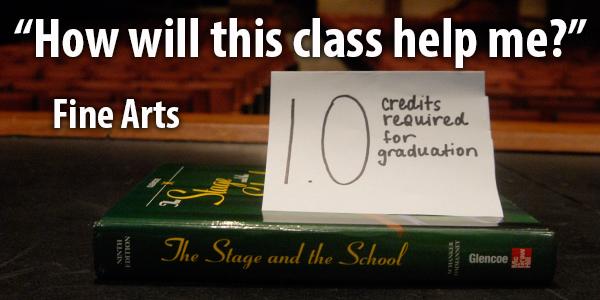Fine Arts
February 27, 2014

Across the nation, schools and districts have been cutting funding for fine arts education, particularly in low-income school districts. However, many proponents of arts programs and education argue schools must provide opportunities for students to participate in the arts to become well-rounded and high-achieving students.
Contrary to many traditional subjects taught in schools such as algebra, physics, economics, or government, the arts provide students with a healthy outlet for stress and other strong emotions while potentially developing a passion in students that can lead to a lifelong love.
“Participation in the art programs has really given me an escape, has kept me relaxed over the years, and has let me do something that I love,” senior Alyssa Vogel said. “I think I’ll always keep it as a hobby, even though I don’t think I will major in it in college.”
For senior McKay Walters, who has taken significantly more fine arts courses than most students on campus (choir, theatre, and band all four years of high school), fine arts have provided an important creative outlet and an opportunity to grow as an individual.
“Fine arts helps us to be more well-rounded and to better ourselves, not just academically, but emotionally as well,” Walters said. “Fine arts allows me to express myself.”
With new educational policies that place a strong emphasis on test scores and education in traditional core subjects, creative fine arts-oriented classes are often forgotten in the policies designed to educate youth.
“For a lot of kids, art classes are a creative outlet,” art teacher Amanda Beller said. “Academics, in a traditional sense, are pushed on students from a pretty young age, so for them to have a place where they can express themselves visually is something that a lot of them need.”
The arts also provide students, particularly those from disadvantaged backgrounds, motivation to complete their studies and graduate from high school. Research has shown that low-income high school students who earned few or no fine arts credits were five times more likely not to graduate from high school than low-income students who earned many fine arts credits, and students who are at risk for not successfully completing their high school educations cite their participation in the arts among their reasons for staying in school.
Beyond a chance at some personal fulfillment, the arts also teach students skills, such as the ability to explain cause and effect, assess significance, make predictions, and frame and test hypotheses, all necessary for success in a variety of fields beyond the arts.
“AP Art History gives students critical thinking skills,” Beller said. “They are able to look at a piece of artwork that they have never seen before and infer what it could mean or what it is about.”
Students who take four years of art and music classes while in high school score, on average, 91 points higher on their SAT exams compared to students who only took a year or less of art and music classes.
For some students, the arts also provide vocational opportunities within the arts industry, which generates more than $300 billion annually and represents six percent of the gross national product of the United States.
All in all, fine arts can have a much greater impact on young adults than simply teaching them to memorize a monologue, to play an instrument, or analyze the paintings of Michelangelo.
“It is more than just appreciating art,” Beller said. “It is truly understanding art and being able to describe it to somebody else.”